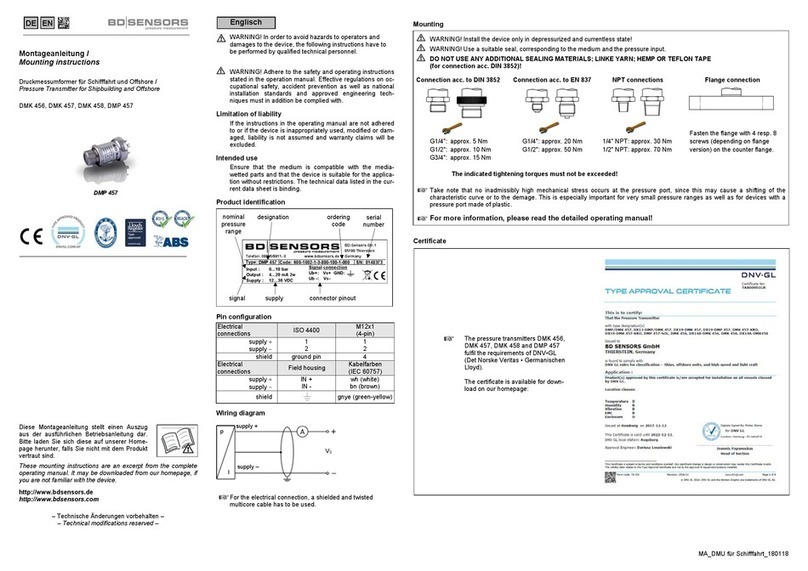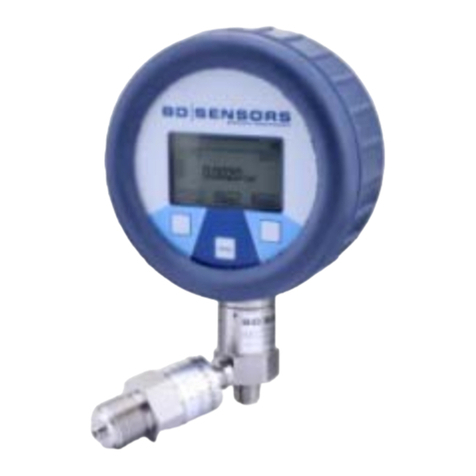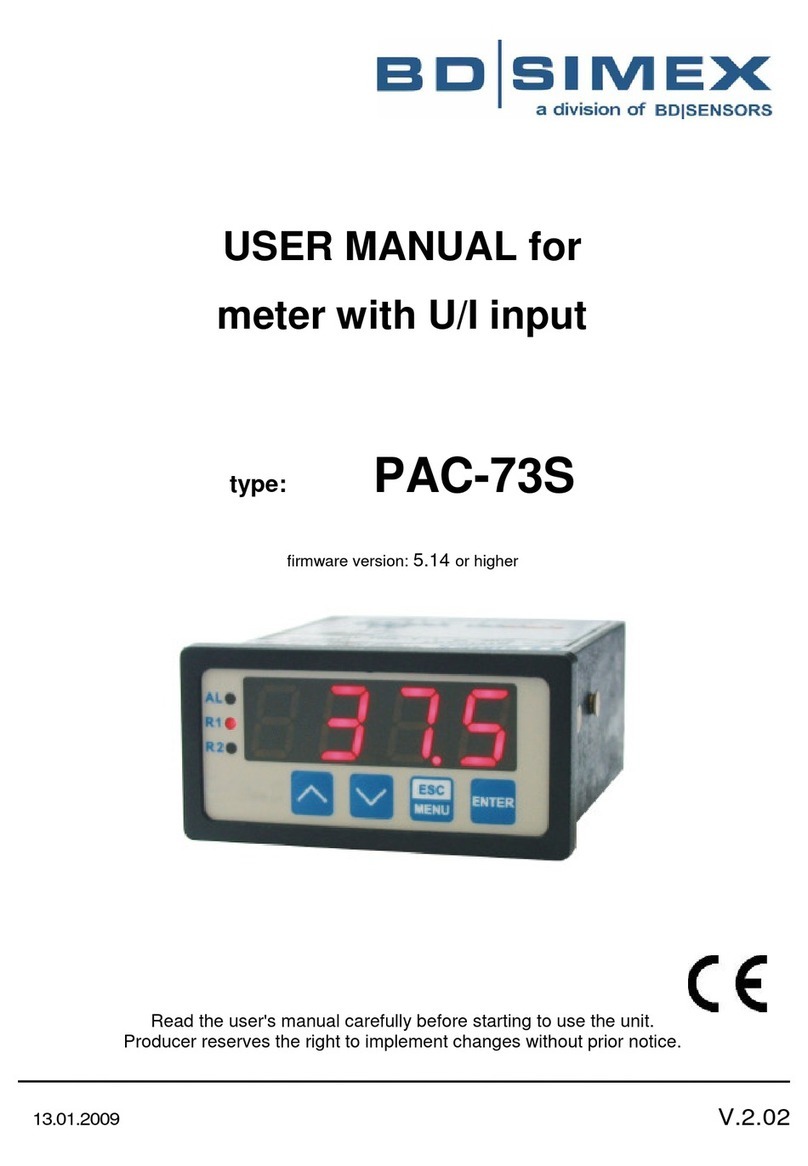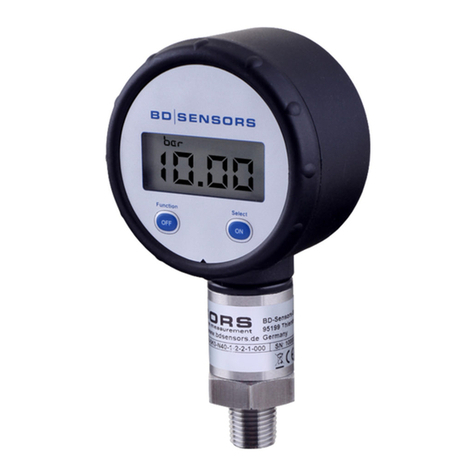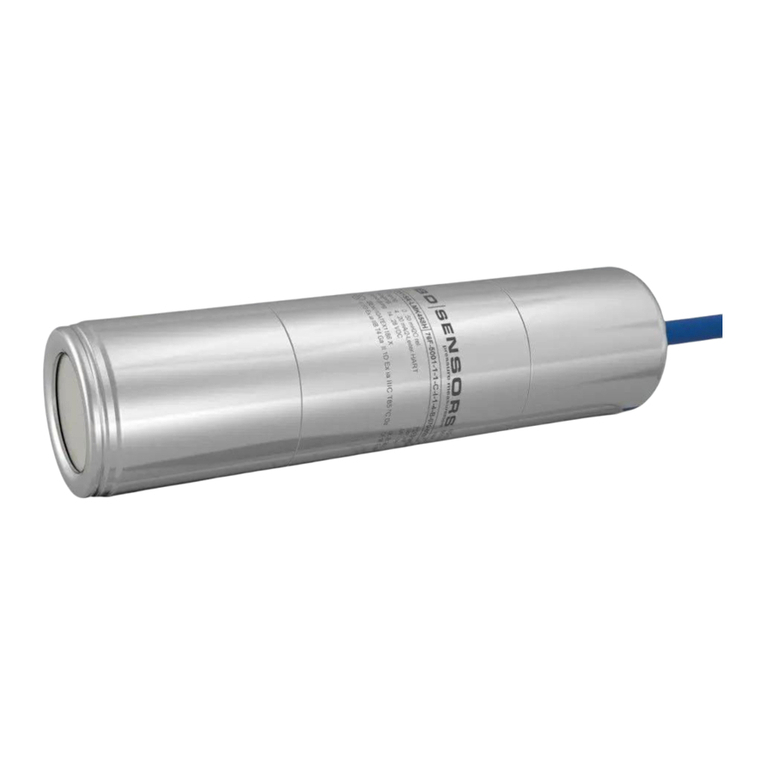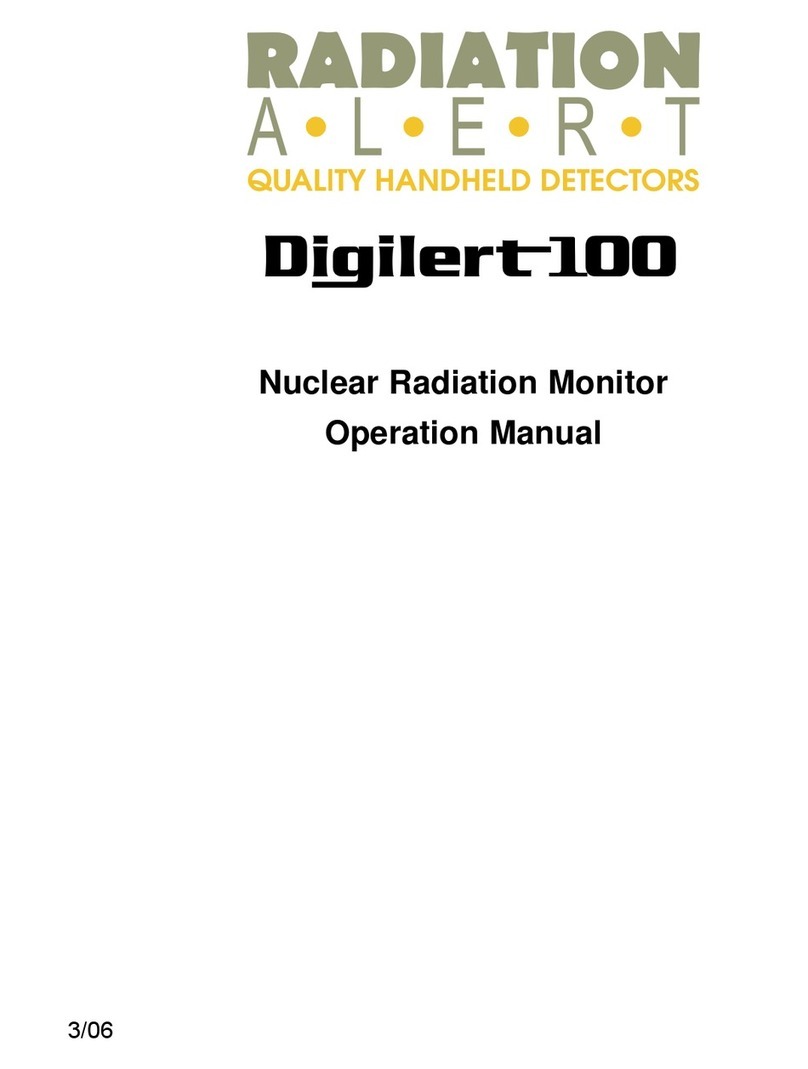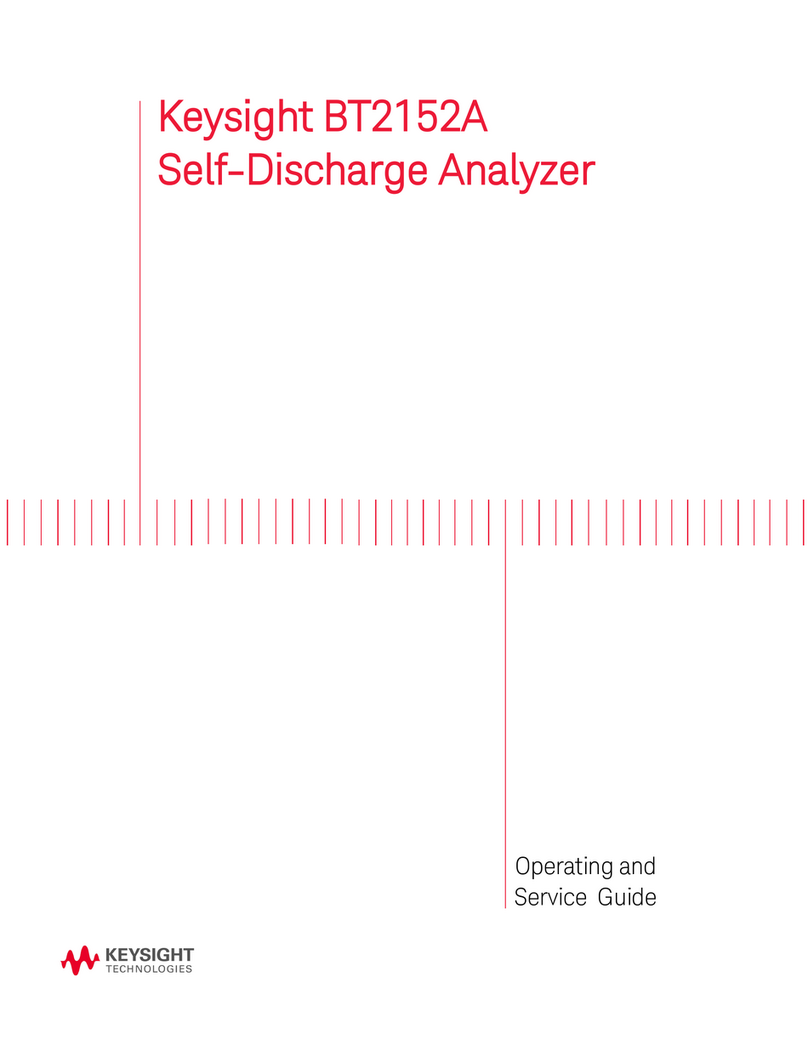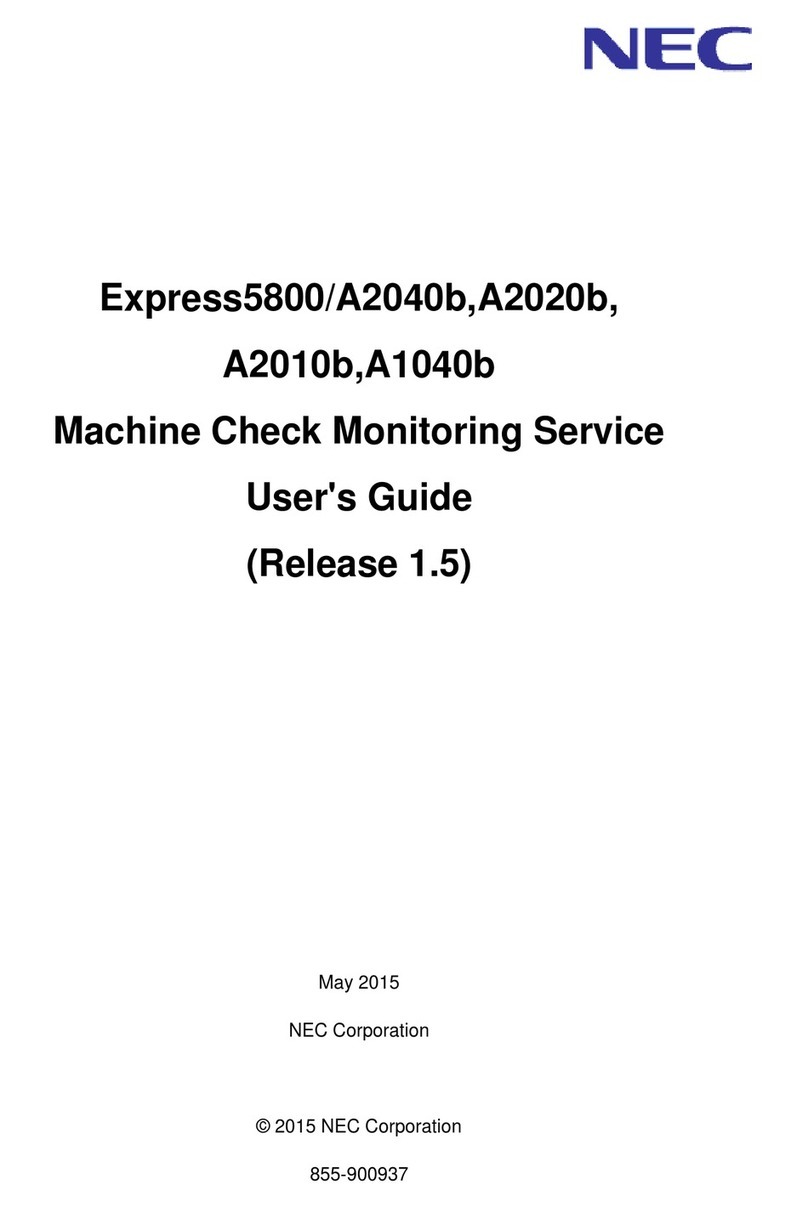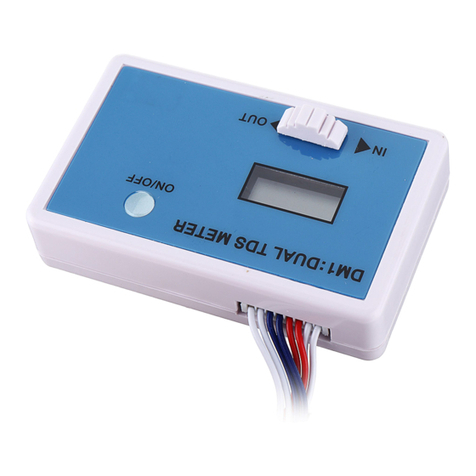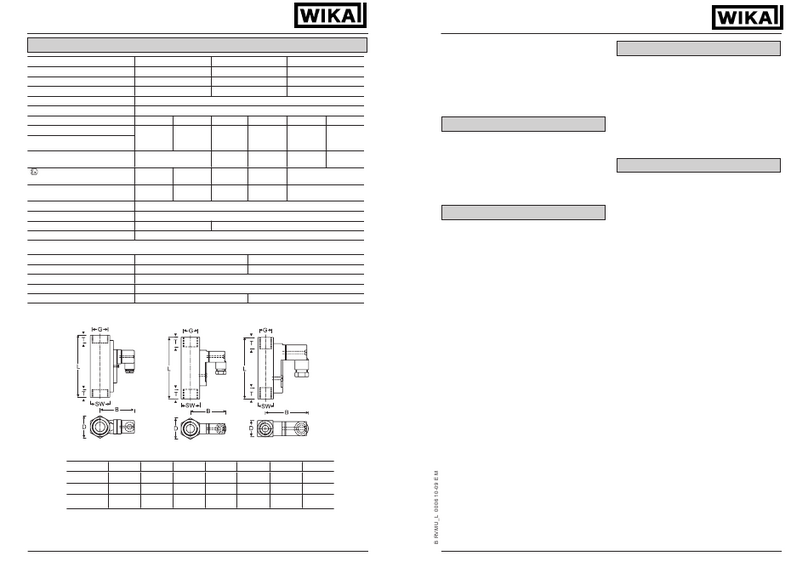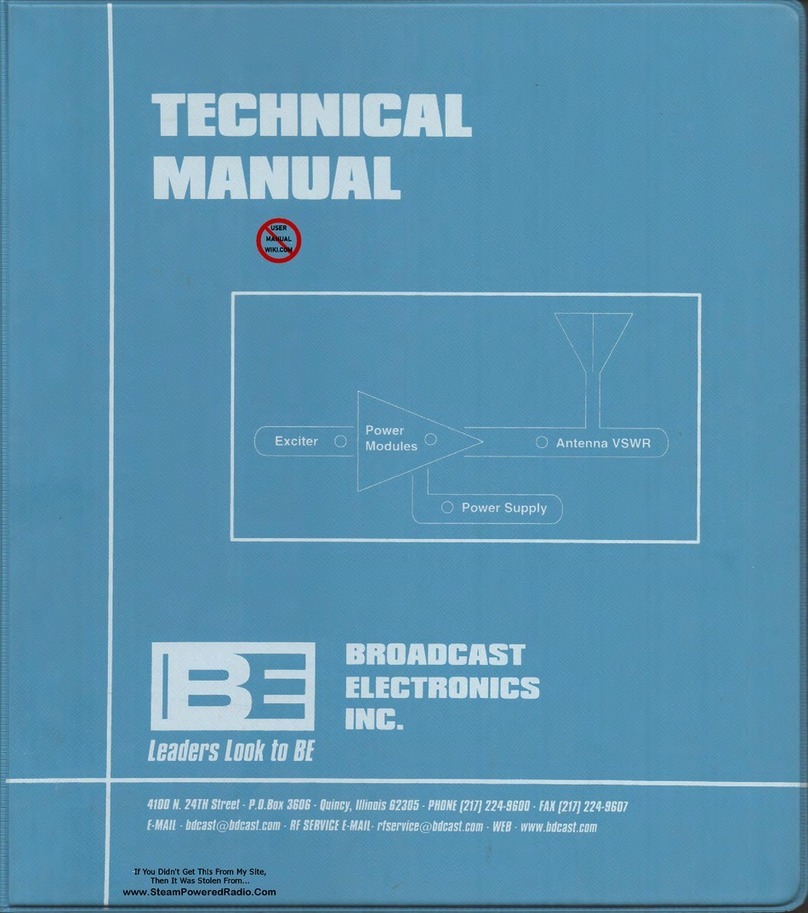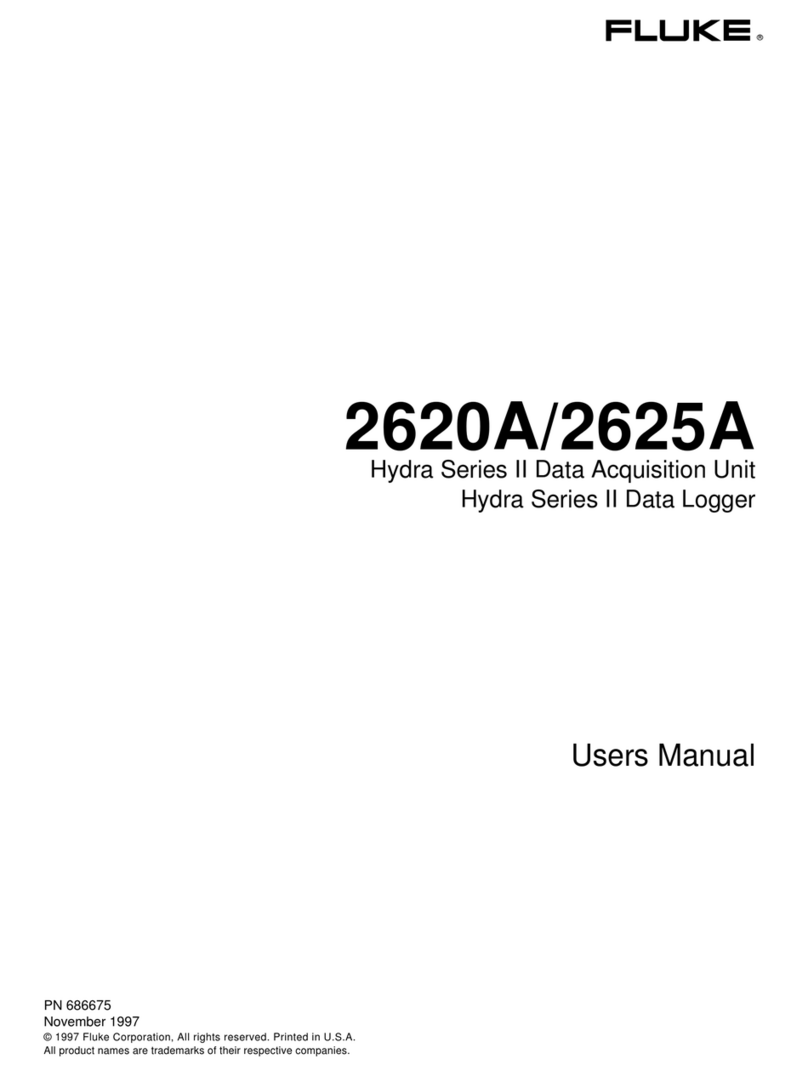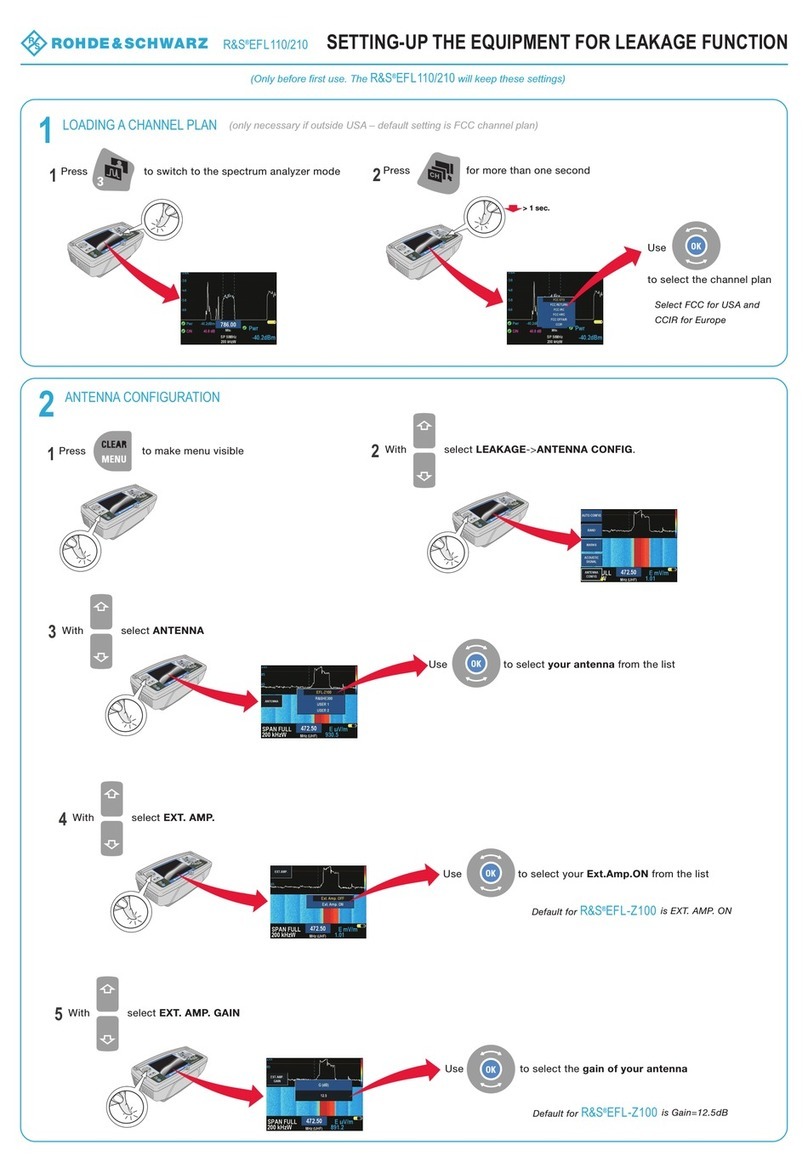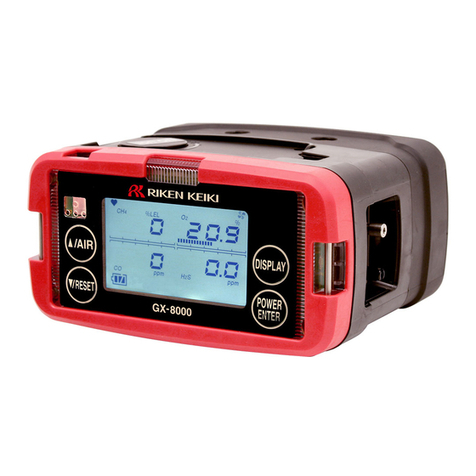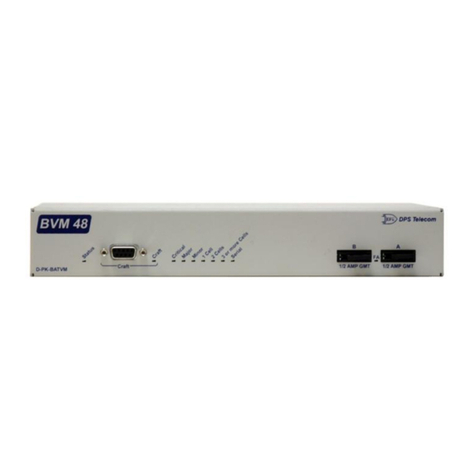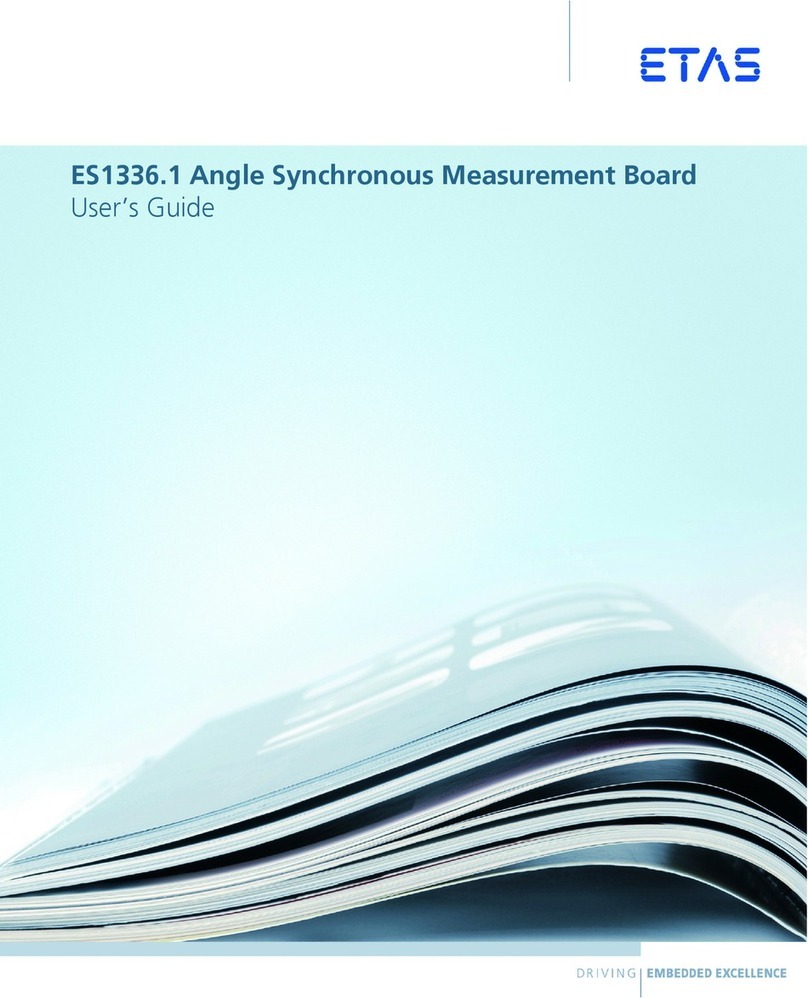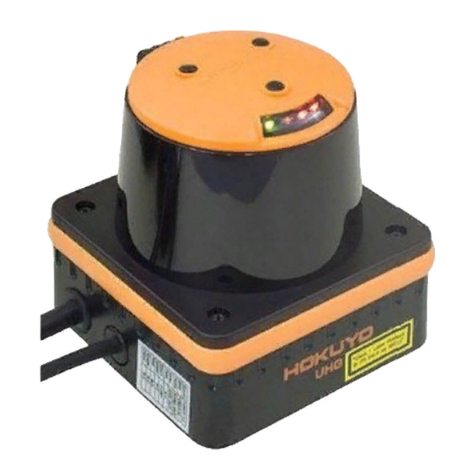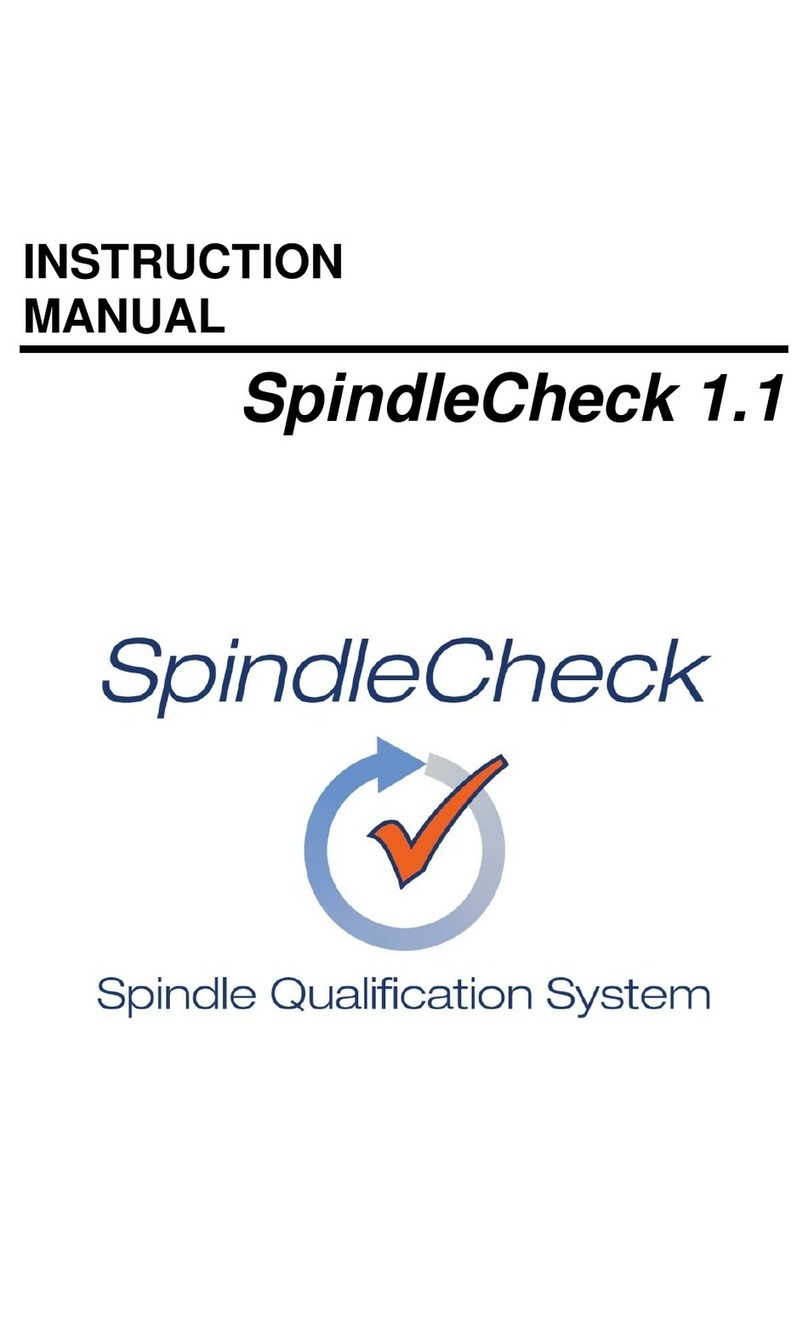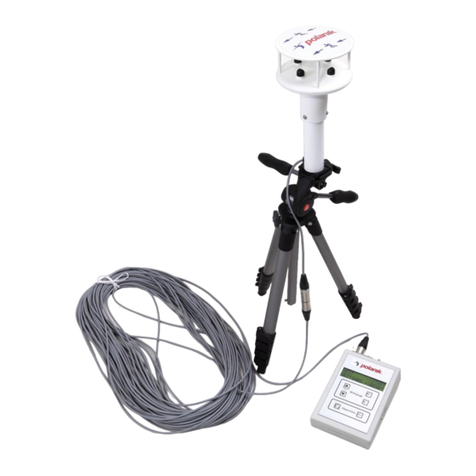BD Sensors BD SIMEX PAC-73T User manual

28.01.2009
V.2.03
USER MANUAL for
meter with thermocouple input
type: PAC-73T
firmware version:
5.16
or higher
Read the user's manual carefully before starting to use the unit.
Producer reserves the right to implement changes without prior notice.

User manual for meter with thermocouple input PAC-73T
2
CONTENTS
1. BASIC REQUIREMENTS AND USER SAFETY....................................................................................... 3
2. GENERAL CHARACTERISTICS.............................................................................................................. 4
3. TECHNICAL DATA .................................................................................................................................. 4
4. DEVICE INSTALLATION ......................................................................................................................... 6
4.1. UNPACKING ................................................................................................................................. 6
4.2. ASSEMBLY ................................................................................................................................... 6
4.3. CONNECTION METHOD............................................................................................................... 8
4.4. MAINTENANCE........................................................................................................................... 13
5. FRONT PANEL DESCRIPTION ............................................................................................................. 13
6. PRINCIPLE OF OPERATION..................................................................................................................14
6.1. MEASUREMENT MODE.............................................................................................................. 14
6.2. DETECTION OF THE PEAK VALUES ..........................................................................................14
6.3. CONTROL OF THE RELAY OUTPUTS ........................................................................................15
6.3.1. One threshold mode ........................................................................................................... 17
6.3.2. Two thresholds mode.......................................................................................................... 18
7. DEVICE PROGRAMMING...................................................................................................................... 19
7.1. PROGRAMMING MENU.............................................................................................................. 19
7.2. PARAMETERS EDITION............................................................................................................. 20
7.2.1. Numeric parameters (digit change mode) ........................................................................... 20
7.2.2. Numeric parameters (slide change mode)........................................................................... 20
7.2.3. Switch parameters (“LIST” type) ......................................................................................... 21
7.3. MENU DESCRIPTION ................................................................................................................. 21
7.3.1. “rEL1” menu........................................................................................................................ 22
7.3.2. “inPt” menu......................................................................................................................... 24
7.3.3. “bri” parameter.....................................................................................................................24
7.3.4. “CoL” menu..........................................................................................................................25
7.3.5. “HOLd” menu...................................................................................................................... 26
7.3.6. “SECu” menu...................................................................................................................... 26
7.3.7. “rS” menu ........................................................................................................................... 27
7.3.8. “Edit” parameter.................................................................................................................. 28
7.3.9. “dEFS” parameter ............................................................................................................... 28
7.3.10. “SErv” menu ..................................................................................................................... 28
7.4. MENU STRUCTURE ................................................................................................................... 29
8. THE ALARM LED .................................................................................................................................. 31
9. THE MODBUS PROTOCOL HANDLING ............................................................................................... 31
9.1. LIST OF REGISTERS.................................................................................................................. 32
9.2. TRANSMISSION ERRORS DESCRIPTION................................................................................. 35
9.3. EXAMPLES OF QUERY/ANSWER FRAMES .............................................................................. 35
10. DEFAULT AND USER'S SETTINGS LIST ............................................................................................38

User manual for meter with thermocouple input PAC-73T
3
Explanation of symbols used in the manual:
- This symbol denotes especially important guidelines concerning the installation and
operation of the device. Not complying with the guidelines denoted by this symbol
may cause an accident, damage or equipment destruction.
IF THE DEVICE IS NOT USED ACCORDING TO THE MANUAL THE USER IS
RESPONSIBLE FOR POSSIBLE DAMAGES.
- This symbol denotes especially important characteristics of the unit. Read any
information regarding this symbol carefully
1. BASIC REQUIREMENTS AND USER SAFETY
-The manufacturer is not responsible for any damages caused by
inappropriate installation, not maintaining the proper technical condition and
using the unit against its destination.
- Installation should be conducted by qualified personnel. During installation all
available safety requirements should be considered. The fitter is responsible for
executing the installation according to this manual, local safety and EMC
regulations.
- The unit must be properly set-up, according to the application. Incorrect
configuration can cause defective operation, which can lead to unit damage or an
accident.
- If in the case of a defect of unit operation there is a risk of a serious threat to
the safety of people or property additional, independent systems and
solutions to prevent such a threat must be used.
- The unit uses dangerous voltage that can cause a lethal accident. The unit
must be switched off and disconnected from the power supply prior to
starting installation of troubleshooting (in the case of malfunction).
- Neighbouring and mating equipment must meet the requirements of appropriate
standards and regulations concerning safety and be equipped with adequate anti-
overvoltage and anti-interference filters.
-Do not attempt to disassemble, repair or modify the unit yourself. The unit
has no user serviceable parts. Units, in which a defect was stated must be
disconnected and submitted for repairs at an authorized service centre.
- In order to minimize fire or electric shock hazard, the unit must be protected
against atmospheric precipitation and excessive humidity.
- Do not use the unit in areas threatened with excessive shocks, vibrations, dust,
humidity, corrosive gasses and oils.

User manual for meter with thermocouple input PAC-73T
4
-Do not use the unit in explosion hazard areas.
- Do not use the unit in areas with significant temperature variations, exposed to
condensation or icing.
- Do not use the unit in areas exposed to direct sunlight.
- Make sure that the ambient temperature (e.g. inside the control box) does not
exceed the recommended values. In such cases forced cooling of the unit must be
considered (e.g. by using a ventilator).
The unit is designed for operation in an industrial environment and must not
be used in a household environment or similar.
2. GENERAL CHARACTERISTICS
The PAC-73T meter is equipped with thermocouple input (K, S, J, T, N, R, B, E). The
measurement range depends on connected thermocouple type. Measurement is linearised by
the polynomial characteristics referred to particular thermocouples and temperature of cold
ends is compenssated automatically. The device has additional measurement range
(-10 ÷ 90 mV) mainly for diagnostics of measurement circuits. Being in this range, unit displays
direct voltage connected to its input (without compensation of cold ends). The result is
presented on 4-digit LED display. For every thermocouples result is displayed as integer
(no decimal point, e.g. 1460) and for mV range with 2 digits after decimal points
(with resolution 0.01 mV e.g. -1.23).
PAC-73T can be equipped with one or two relay (or OC type) outputs. Device PAC-73T is
equipped with RS-485 / Modbus RTU communication interface and 24 V/100 mA supply output
for free use. The meter can be ordered in two power supply versions.
3. TECHNICAL DATA
Power supply voltage 85...230...260 V
AC/DC
; 50 ÷ 60 Hz
(depending on version) or 19...24...50 V
DC
; 16...24...35 V
AC
External fuse (required) T - type, max. 2 A
Power consumption max. 4.5 VA @ 85 ÷ 260 V
AC/DC
max. 4.5 VA @ 16 V ÷ 35 V
AC
max. 4.5 W @ 19 V ÷ 50 V
DC
Measurement input thermocouple type: K, S, J, T, N, R, B, E
Measurement range K: -200 °C ÷ +1370 °C
S: -50 °C ÷ +1768 °C
J: -210 °C ÷ +1200 °C
T: -200 °C ÷ +400 °C
N: -200 °C ÷ +1300 °C
R: -50 °C ÷ +1768 °C
B: +250 °C ÷ +1820 °C
E: -200 °C ÷ +1000 °C

User manual for meter with thermocouple input PAC-73T
5
Measurement accuracy ± 0.25 % ± one digit
Accuracy of ends temperature ÷ 1 °C
compensation
Outputs
relay: 0, 1 or 2 NO, 1 A/250 V
AC
(cos ϕ= 1)
or OC-type: 0, 1 or 2, 30 mA / 30 V
DC
/ 100 mW
sensor power supply: 24 V +5 %, -10 % / max. 100 mA, stabilized
Communication interface RS-485, 8N1 and 8N2, Modbus RTU, not separated
Baud rate 1200 bit/sec ÷ 115200 bit/sec
Display LED, 4 digit, 13 mm height, two-colour (red and green)
(depending on version) or (for IP 65 version) 5 digit, 9 mm height, red
Data memory non-volatile memory, EEPROM type
Protection level IP 65 (from front, after using waterproof cover)
IP 40 (from front)
IP 20 (housing and connection clips)
Housing type panel
Housing material NORYL - GFN2S E1
Housing dimensions 72 x 36 x 97 mm
Mounting hole 66.5 x 32.5 mm
Assembly depth min. 102 mm
Panel thickness max. 5 mm
Operating temperature 0 °C to +50 °C
Storage temperature -10 °C to +70 °C
Humidity 5 to 90 % no condensation
Altitude up to 2000 meters above sea level
Screws tightening max. torque 0.5 Nm
Max. connection leads diameter 2.5 mm
2
Safety requirements according to: PN-EN 61010-1
installation category: II
pollution degree: 2
voltage in relation to ground: 300 V
AC
insulation resistance: >20 MΩ
insulation strength between power supply and
input/output terminal: 1min. @ 2300 V
insulation strength between relays terminal:
1min. @ 1350 V
EMC according to: PN-EN 61326

User manual for meter with thermocouple input PAC-73T
6
This is a class A unit. In housing or a similar area it can cause radio frequency
interference. In such cases the user can be requested to use appropriate
preventive measures.
4. DEVICE INSTALLATION
The unit has been designed and manufactured in a way assuring a high level of user safety and
resistance to interference occurring in a typical industrial environment. In order to take full
advantage of these characteristics installation of the unit must be conducted correctly and
according to the local regulations.
- Read the basic safety requirements on page 3 prior to starting the installation.
- Ensure that the power supply network voltage corresponds to the nominal voltage
stated on the unit’s identification label.
- The load must correspond to the requirements listed in the technical data.
- All installation works must be conducted with a disconnected power supply.
- Protecting the power supply clamps against unauthorized persons must be taken
into consideration.
4.1. UNPACKING
After removing the unit from the protective packaging, check for transportation damage. Any
transportation damage must be immediately reported to the carrier. Also, write down the unit
serial number on the housing and report the damage to the manufacturer.
Attached with the unit please find:
- user’s manual,
- warranty,
- assembly brackets - 2 pieces.
4.2. ASSEMBLY
- The unit is designed for mounting indoor inside housings (control panel,
switchboard) assuring appropriate protection against electric impulse waves. Metal
housing must be connected to the grounding in a way complying with the governing
regulations.
- Disconnect the power supply prior to starting assembly.
- Check the correctness of the performed connections prior to switching the unit on.
In order to assembly the unit, a 66.5 mm x 32.5 mm mounting hole (Figure 4.1) must
be prepared. The thickness of the material of which the panel is made must not
exceed 5 mm. When preparing the mounting hole take the grooves for catches
located on both sides of the housing into consideration (Figure 4.1).
Place the unit in the mounting hole inserting it from the front side of the panel, and
then fix it using the brackets (Figure 4.2). The minimum distances between assembly
holes’ axes - due to the thermal and mechanical conditions of operation – are
91 mm x 57 mm (Figure 4.3).

User manual for meter with thermocouple input PAC-73T
7
Figure 4.1. Mounting hole dimensions
Figure 4.2. Installing of brackets, and dimensions of connectors

User manual for meter with thermocouple input PAC-73T
8
Figure 4.3. Minimum distances when assembly of a number of units
4.3. CONNECTION METHOD
Caution
- Installation should be conducted by qualified personnel. During installation all
available safety requirements should be considered. The fitter is responsible for
executing the installation according to this manual, local safety and EMC
regulations.
- The unit is not equipped with an internal fuse or power supply circuit breaker.
Because of this an external time-delay cut-out fuse with minimal possible nominal
current value must be used (recommended bipolar, max. 2 A) and a power supply
circuit-breaker located near the unit. In the case of using a monopolar fuse it must
be mounted on the phase cable (L).
- The power supply network cable diameter must be selected in such a way that in
the case of a short circuit of the cable from the side of the unit the cable shall be
protected against destruction with an electrical installation fuse.
- Wiring must meet appropriate standards and local regulations and laws.
- In order to secure against accidental short circuit the connection cables must be
terminated with appropriate insulated cable tips.
- Tighten the clamping screws. The recommended tightening torque is 0.5 Nm.
Loose screws can cause fire or defective operation. Over tightening can lead to
damaging the connections inside the units and breaking the thread.
- In the case of the unit being fitted with separable clamps they should be inserted
into appropriate connectors in the unit, even if they are not used for any
connections.
- Unused clamps (marked as n.c.) must not be used for connecting any
connecting cables (e.g. as bridges), because this can cause damage to the
equipment or electric shock.

User manual for meter with thermocouple input PAC-73T
9
-
If the unit is equipped with housing, covers and sealing packing, protecting against
water intrusion, pay special attention to their correct tightening or clamping. In the
case of any doubt consider using additional preventive measures (covers, roofing,
seals, etc.). Carelessly executed assembly can increase the risk of electric shock.
- After the installation is completed do not touch the unit’s connections when it is
switched on, because it carries the risk of electrical shock.
Due to possible significant interference in industrial installations appropriate measures
assuring correct operation of the unit must be applied. To avoid the unit of improper
indications keep recommendations listed below.
- Avoid common (parallel) leading of signal cables and transmission cables together
with power supply cables and cables controlling induction loads (e.g. contactors).
Such cables should cross at a right angle.
- Contactor coils and induction loads should be equipped with anti-interference
protection systems, e.g. RC-type.
- Use of screened signal cables is recommended. Signal cable screens should
be connected to the earthing only at one of the ends of the screened cable.
- In the case of magnetically induced interference the use of twisted couples of signal
cables (so-called “spirals”) is recommended. The spiral (best if shielded) must be
used with RS-485 serial transmission connections.
- In the case of interference from the power supply side the use of appropriate anti-
interference filters is recommended. Bear in mind that the connection between the
filter and the unit should be as short as possible and the metal housing of the filter
must be connected to the earthing with largest possible surface. The cables
connected to the filter output must not run in parallel with cables with interference
(e.g. circuits controlling relays or contactors).
Connections of power supply voltage and measurement signals are executed using the screw
connections on the back of the unit’s housing.
Figure 4.4. Method of cable insulation replacing and cable terminals

User manual for meter with thermocouple input PAC-73T
10
Figure 4.5. Terminals description (relay outputs)
Figure 4.6. Terminals description (OC-type outputs)
All connections must be made while power supply is disconnected!

User manual for meter with thermocouple input PAC-73T
11
Figure 4.7. Connection of power supply and relays
Contacts of relay outputs are not equipped with spark suppressors. While use
the relay outputs for switching of inductive loads (coils, contactors, power
relays, electromagnets, motors etc.) it is required to use additional
suppression circuit (typically capacitor 47 nF/min. 250 V
AC
in series with
100R/5 W resistor), connected in parallel to relay terminals or (better) directly
on the load. In consequence of using the suppression circuit, the level of
generated electromagnetic disturbances is lower, and the life of relay contacts
rises.
Depending on version:
85...230...260 V
AC/DC
or
19...24...50 V
DC
; 16...24...35 V
AC

User manual for meter with thermocouple input PAC-73T
12
Figure 4.8. Examples of suppression circuit connection:
a) to relay terminals; b) to the inductive load
Figure 4.9. Example of OC-type outputs connection

User manual for meter with thermocouple input PAC-73T
13
4.4. MAINTENANCE
The unit does not have any internal replaceable or adjustable components available to the user.
Pay attention to the ambient temperature in the room where the unit is operating. Excessively
high temperatures cause faster ageing of the internal components and shorten the fault-free
time of unit operation.
In cases where the unit gets dirty do not clean with solvents. For cleaning use warm water with
small amount of detergent or in the case of more significant contamination ethyl or isopropyl
alcohol.
Using any other agents can cause permanent damage to the housing.
Product marked with this symbol should not be placed in municipal waste. Please
check local regulations for disposal and electronic products.
5. FRONT PANEL DESCRIPTION
Symbols and functions of push-buttons:
Symbol used in the manual: [ESC/MENU]
Functions:
•Enter to main menu (press and hold by at least 2 sec.)
•Exit the current level and Enter to previous menu (or measure mode)
•Cancel the changes made in parameter being edited
Symbol used in the manual: [ENTER]
Functions:
•Start to edit the parameter
•Enter to the sub-menu
•Confirmation of changes made in parameter being edited
Symbol used in the manual: [^] [v]
Functions:
•Change of the present menu,
•Modification of the parameter value,
•Change of the display mode.

User manual for meter with thermocouple input PAC-73T
14
6. PRINCIPLE OF OPERATION
After turning the power supply on, device ID and software version are showed on the display,
next the controller goes to the measurement mode.
6.1. MEASUREMENT MODE
In the measure mode the measurement results, are displayed on the display. If the result of
measurement exceeds the permissible measurement range, warning “-Hi-“ or “-Lo-“ is
displayed rather than calculated result, depends on exceeded value.
In the measurement mode user can check main thresholds values. After pressing [^] or [v]
button, name of the threshold (e.g. “rEL1”) and his value will be displayed on the display in
alternating mode. If [^] or [v] will be pressed in 5 sec again, the next threshold will be displayed,
else the device comes back to the measurement mode. If a free access is enabled (see
description of “SECu” menu), user can change the value of particular threshold pressing button
[ENTER] (see: PARAMETERS EDITION).
All accessible parameters can be changed by entering the menu (see: DEVICE
PROGRAMMING). Use the local keyboard or the remote controller to do it. (Note: all parameters
can be remote changed via RS-485 interface).
Configuration of the device (via menu or RS-485 interface) do not stops measures.
6.2. DETECTION OF THE PEAK VALUES
The PAC-73T controller is equipped with peaks detection function. It can detect a peaks of the
input signal and display their values. Presets connected with this function are placed in “HOLd”
menu (see description of “HOLd” menu). The detection of the peak can be done if the
measured signal raises and drops of value at least equal to parameter “PEA”. Detected peaks
are displayed during the time defined by parameter “timE”. If a new peak will be detected while
one is displayed, this new peak will be displayed and display time counter will be cleared
(Figure 6.1). If no peaks are detected while time “timE” elapses, device starts to show the
current value of input signal again.
The relays/LEDs can be controlled depend on the current value of input signal or the peak value
(see “HOLd” menu).

User manual for meter with thermocouple input PAC-73T
15
Figure 6.1. Process of peaks detection
6.3. CONTROL OF THE RELAY OUTPUTS
The control of the object (measured signal) is realized via relay outputs. Front panel LEDs
named “R” indicates the state of particular relay output.
If device is not equipped with one or more relay outputs, menus refer to this relays
are available, but apply to LED indicators only. In such case LEDs indicates
exceeding of particular thresholds.
Modes of the control can be changed depend on the values of parameters “SEtP”, “SEt2”,
“HYSt”, “modE”, “t on”, “toFF”, “unit” and “AL”. Depend on “modE” parameter, relays can
be not used or controlled over one or two thresholds values.
If one threshold is used (Figure 6.2) the relay can be turned on (“modE” =“on”) or off
(“modE” =“oFF”) when the input signal value is contained in zone A. If two thresholds are
used (Figure 6.3) the relay will be turned on when value of input signal is contained in zone A
(“modE” = “in”) or zone B (“modE” = “out”) and turned off if the signal is contained in the
second one.

User manual for meter with thermocouple input PAC-73T
16
Figure 6.2. One threshold control of the relay/LED outputs
Figure 6.3. Two thresholds control of the relay/LED outputs
The relay outputs and LEDs (named R) can be controlled depend on both - the
current value and the peak value (when peak detection is active) of the input signal.

User manual for meter with thermocouple input PAC-73T
17
6.3.1. One threshold mode
Figure 6.4 presents the principle of relay outputs operation for one threshold mode, and an
example values of other parameters.
Description:
A, B, C, D - points where measured signal exceeds border values (expected value ± allowed deviation)
B
ON
, B
OFF
, D
ON
, D
OFF
- relays state changes moments: (for “t on” > 0, “toFF” > 0)
t
A
, t
B
, t
C
, t
D
-time periods while input signal is in zone A or zone B
Figure 6.4. Principle of LED/relay output operation for one threshold mode
Parameter “SEtP” sets a threshold of the relay, and parameter “HYSt” sets a hysteresis of
the relay (Figure 6.4 a). The relay can change his state only when input value exceeds (over or
under) border value and t
A,
t
B
, t
C
, t
D
times (Figure 6.4) are bigger than the time defined by
parameters “t on”, “toFF” and “unit”. Border values means values equal
threshold+hysteresis and threshold-hysteresis respectively.
If “t on” and “toFF” parameters are set to “0”, then the relay state will be changed as soon as
input value exceeds any of the border values (see points A and C, Figure 6.4 a, b, c).
If values of “t on” or/and “toFF” are positive, then relay state will be turned on if the input value
exceeds the border values and stay bigger (or lower) during at least “t on” (see points B
ON
,
D
ON
, Figure 6.4 a, d, e). Similarly, the relay will be turned off if time “toFF” elapse since the
input signal value exceeds any of the border values (see points B
OFF
, D
OFF
, Figure 6.4 a, d, e).

User manual for meter with thermocouple input PAC-73T
18
If t
A
,t
B
,t
C
or t
D
(when input signal stay in zone A or zone B) are lower than parameters “t on”
or “toFF”, the relay will not change his state (see points A and C, Figure 6.4 a, d, e).
The state of relay output while the input value exceeds the border values (points A, B, C, D) is
described by parameter “modE”. The relay can be turned on (“modE” =“on”), or turned off
(“modE” =“oFF”) when input signal value is contained in zone A (Figure 6.4 a).
The parameter “AL” allow user to set the relay output behaviour in critical situations (e.g. Input
values exceeds permissible measurement range). User can select that the relays will be
turned on, turned off, or not changed in critical situations.
All parameters connected with relay outputs are described in paragraph “rEL1” menu.
6.3.2. Two thresholds mode
Description:
A, B, C, D, E - points where measured signal exceeds border values (expected value ± allowed deviation)
B
ON
, B
OFF
, C
ON
, C
OFF
, - relays state changes moments: (for “t on” > 0, “toFF” > 0)
E
ON
, E
OFF
t
A
, t
B
, t
C
, t
D
, t
E
- time periods while input signal is in zone A or zone B
Figure 6.5. Principle of LED/relay output operation for two thresholds mode

User manual for meter with thermocouple input PAC-73T
19
Figure 6.5 presents the principle of relay outputs operation for two thresholds mode, and an
example values of other parameters. In this mode parameter “SEt2” is accessible in common
with “SEtP”, this parameter describes a second threshold of the relay output. The parameters
“HYSt”, “modE”, “t on”, “toFF”, “unit” and “AL” are connected with both “SEtP” and
“SEt2” thresholds. While the controlling process, the relay output changes his state depends of
both “SEtP” and “SEt2” thresholds in similar way as it was described in one threshold mode.
If two threshold mode is used, “modE” parameter defines state of the relay output when the
input value occurs in a particular zone defined by border values of both thresholds. The relay
can be turned on if the input value is contained in zone A (“modE” =“in”) or zone B
(“modE” =“out”) and turned off if it is contained in the second one (Figure 6.5).
The sequence of thresholds “SEtP” and “SEt2” can be set in any order, due to the
control of relay outputs is done depend on difference between thresholds values
(zone A ) and outside of threshold values (zone B).
7. DEVICE PROGRAMMING
The device menu allow user to set all parameters connected to operation of measurement
input, control modes, critical situations behaviour, communication via RS-485 and access
settings. The meaning of the particular parameters is described in paragraph MENU
DESCRIPTION.
Some of the parameters can be accessed without menu entering (quick view mode). After
pressing [^] or [v] button, name of the threshold (e.g. “rEL1”) and his value will be displayed
on the display in alternating mode. If [^] or [v] will be pressed in 5 sec again, the next threshold
will be displayed, else the device comes back to the measurement mode. If a free access is
enabled (see description of “SECu” menu), user can change the value of particular threshold
pressing button [ENTER] (see: PARAMETERS EDITION).
If particular parameter has been changed and confirmed in quick view mode, its new
value is displayed in alternating mode with parameter name by few seconds.
Confirmed changes may be checked or user can switch viewed parameter pressing
[^] or [v] button.
7.1. PROGRAMMING MENU
To enter main menu (being in the measurement mode) operator must to press and hold at least
2 sec. [ESC/MENU] button.
If the user password is defined (see parameter “Scod“, menu “SECU”), operator have to enter
correct one before proceeding to menu options. Entering of the passwords is similar to the
edition of numeric parameters (see:
PARAMETERS EDITION
)
,
however presently editing digit is
showed only on the display, other digits are replaced by “-” sign.
After entering of last digit of the password first menu position will be displayed (if the password
is correct) or warning “Err” in other case.
Pay attention when device parameters are being changed. If it is possible, turn off
controlled installation (machine).

User manual for meter with thermocouple input PAC-73T
20
Functions of the buttons while sub-menu and parameters choice:
Selection of sub-menu or parameter for editing. Name of selected item
(sub-menu or parameter) is displayed.
Operation of [ENTER] button depend on present menu position:
•if the name of some sub-menu is displayed - enter this sub-menu; name of
the first parameter (or next level sub-menu) is displayed.
•if the name of some parameter is displayed - enter the edition of this
parameter; present value of the parameter is displayed.
[ESC/MENU] button allow user to exit present menu level and goes to upper
level menu (or measurement mode).
After about 1 min. since last use of the buttons, device exits the menu mode and
returns to the measurement mode (only if no parameters are in editing mode).
7.2. PARAMETERS EDITION
To start edition of any parameter user should select name of desired one using [^] [v] buttons
and then press [ENTER].
7.2.1. Numeric parameters (digit change mode)
Numerical parameters are displayed as decimal numbers. The mode of its new value entering
depends on chosen edit method (see parameter “Edit”).
In mode “by digit” (“Edit”=”dig”) pressing one of the keys [^] or [v] causes change of current
position (flashing digit) or the sign (+/-). Short pressing of the [ENTER] button causes change of
the position (digit).
Press [ENTER] at least 2 seconds to accept the changes, after that question “SEt?” is
displayed, and user must to confirm (or cancel) the changes. To conform changes (and story it
in EEPROM) press [ENTER] button shortly after “SEt?” is displayed. To cancel the changes
press [ESC] button shortly after “SEt?” is displayed. After that device returns to the menu.
7.2.2. Numeric parameters (slide change mode)
In “slide change” mode (“Edit”=”Slid”), buttons [^] and [v] has different functions.
To increase edited value press (or press and hold) [^] button only, the increasing became
quickest as long as button [^] is pressed. To slow down the increasing, button [v] can be used.
If [v] is pressed shortly (and button [^] is still pressed), increasing slow down for a moment
only, if [v] is pressed and held while button [^] is still pressed the increasing slow down and will
be kept on lower speed.
To decrease edited value press (or press and hold) [v] button only. The decreasing became
quickest as long as button [v] is pressed. To slow down the decreasing, button [^] can be used.
If [^] is pressed shortly (and button [v] is still pressed), decreasing slow down for a moment only,
if [^] is pressed and held while button [v] is still pressed the decreasing slow down and will be
kept on lower speed.
Table of contents
Other BD Sensors Measuring Instrument manuals
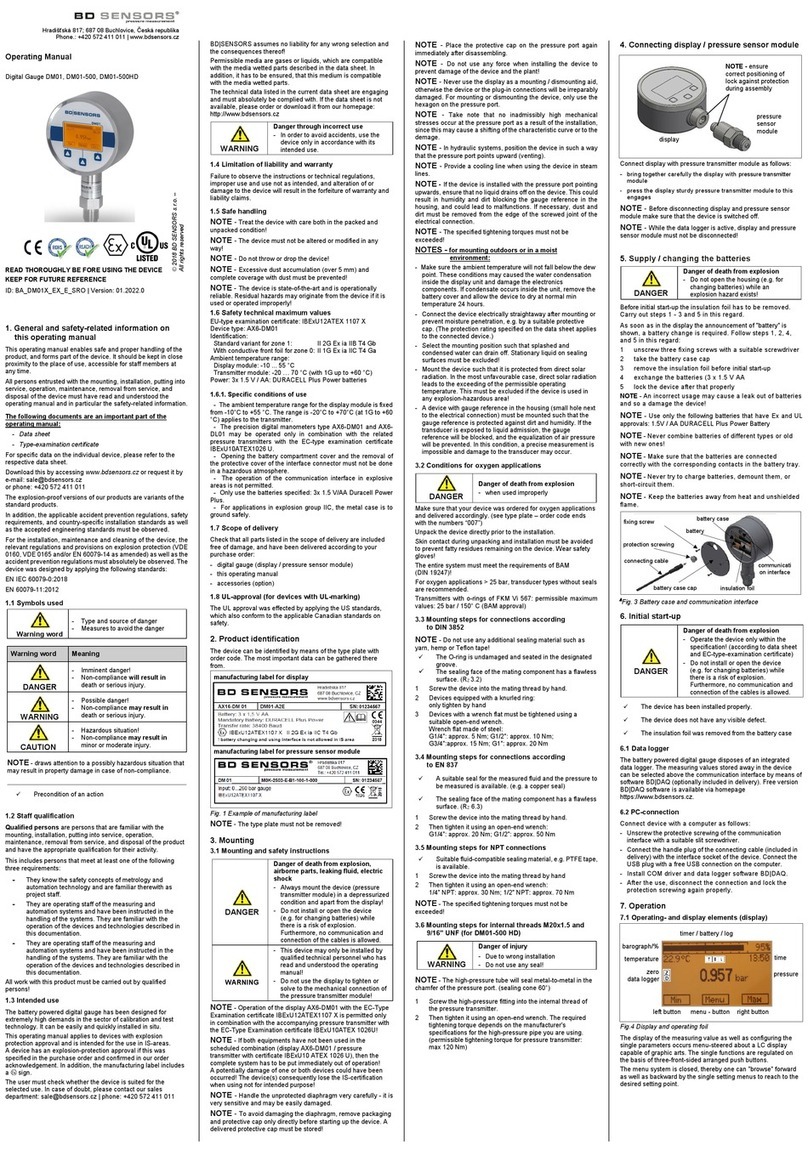
BD Sensors
BD Sensors DM01 User manual
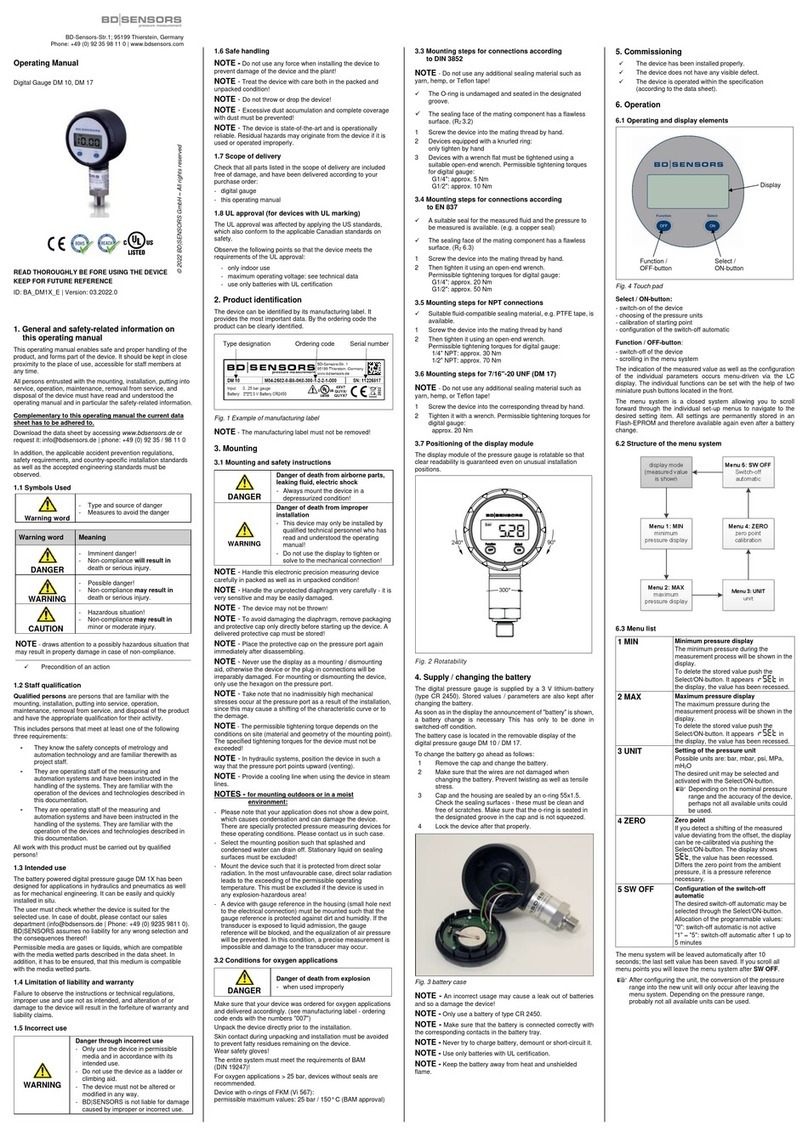
BD Sensors
BD Sensors DM 10 User manual

BD Sensors
BD Sensors LMK 457 User manual
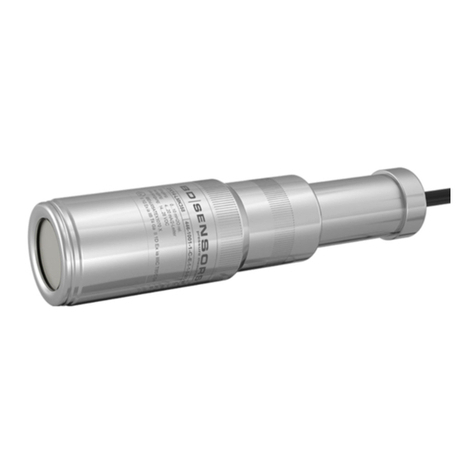
BD Sensors
BD Sensors LMK 306 User manual

BD Sensors
BD Sensors BAROLI 02 User manual
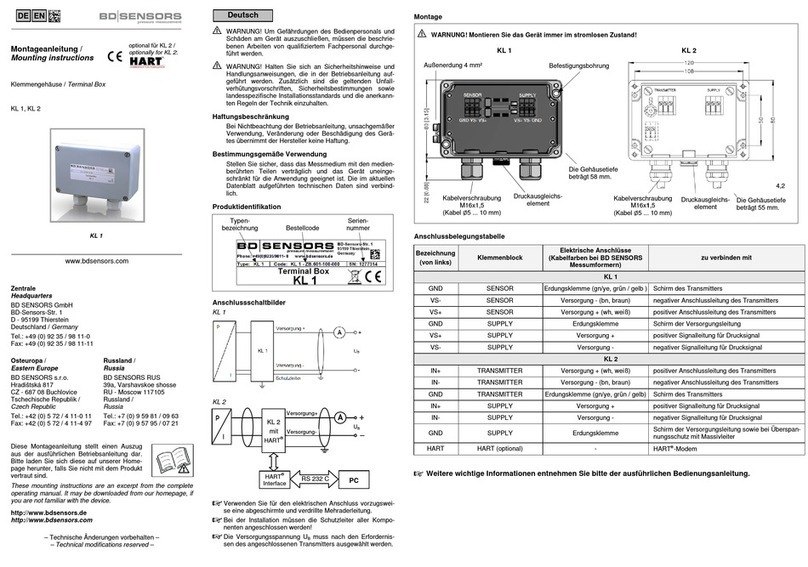
BD Sensors
BD Sensors KL 1 User manual
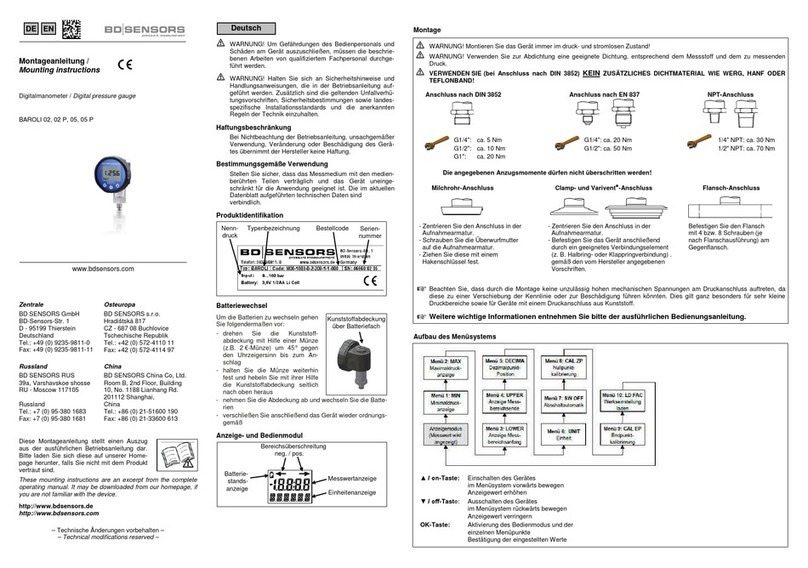
BD Sensors
BD Sensors BAROLI 02 User manual

BD Sensors
BD Sensors LMK 457 User manual
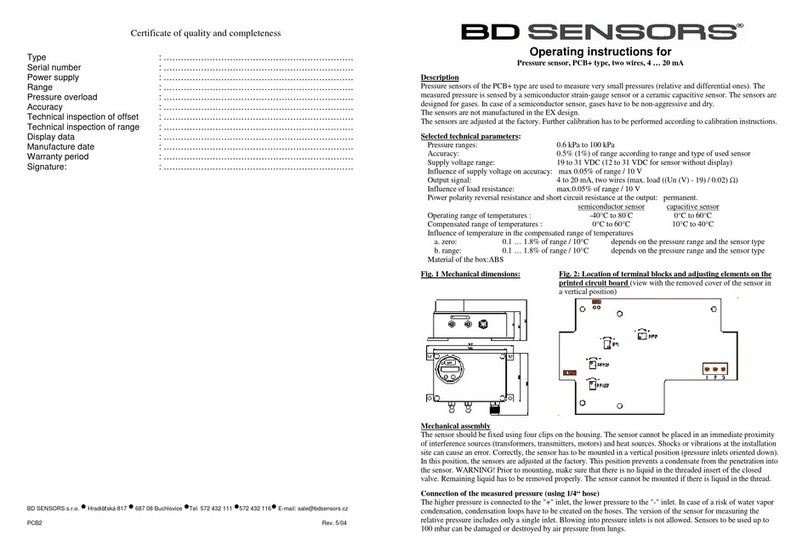
BD Sensors
BD Sensors PCB+ User manual
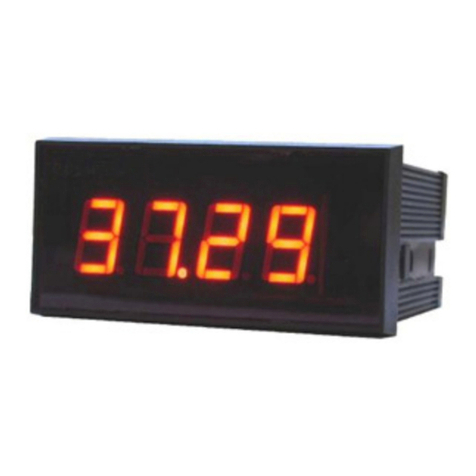
BD Sensors
BD Sensors BD SIMEX PAD-73S User manual

